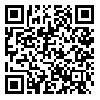BibTeX | RIS | EndNote | Medlars | ProCite | Reference Manager | RefWorks
Send citation to:
URL: http://salmandj.uswr.ac.ir/article-1-791-en.html
2- Department of Nursing, Institute of Meshginshahr Higher Education of Health, Ardabil University of Medical Sciences, Ardabil, Iran.
3- Department of Nursing, University of Social Welfare and Rehabilitation Sciences, Tehran, Iran. ,
Objectives: Fear of falling may restrict activities that can increase risk of falling. The aim of this study was to investigate the incidence of falls and fear of falling and their relationship.
Methods & Materials: This descriptive cross-sectional, and analytical study was performed on 160 institutionalized old people (130 females, 30 males) aged 65 and older that all of them were enrolled by sampling. After receiving their informed consents, data were collected by demographic form, fall frequency form and falls efficacy scale (FSE) questionnaire. Descriptive statistics was used for data classification and inferential statistics including 1-way ANOVA, Independent t test, and the Pearson correlation were used for data analysis. Validity and reliability of FSE questionnaire was confirmed after its analysis (The Cronbach α=95%).
Results: Among 160 subjects, the majority of the elderly were women (81.2%), the mean (SD) of participants’ age was 67.63(9.07) years. The mean (SD) of falls was 2.6(0.85). About 46.9% of the elderly have fallen 3 times, 33.8% of them have fallen 2 times and 9.4% have fallen 1 time in the past 6 months, while the majority of the elderly (76.2%) had moderate fear of falling. There was significant difference between factors of sex and using drugs with the number of falls (P<0.001). Significant difference was seen between fear of falling and sex (P<0.05) and residence time (P=0.02). The Pearson correlation showed
a significant relationship between the number of falls and fear of falling with confidence level of 99%(P<0.001).
Conclusion: Because of the high prevalence of falls and fear of falling in the elderly and their direct relationship with each other, necessary measures should be taken for prevention and controlling them to improve the welfare of the elderly people.
Received: 2015/06/20 | Accepted: 2015/09/23 | Published: 2016/01/01
| Rights and permissions | |
 |
This work is licensed under a Creative Commons Attribution-NonCommercial 4.0 International License. |





